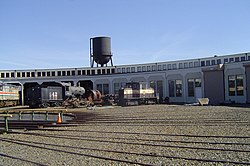Spencer Shops
|
Southern Railway Spencer Shops
|
|

Spencer Shops turntable service facility
|
|
| Location | Spencer, North Carolina |
|---|---|
| Coordinates | 35°41′13″N 80°26′10″W / 35.68694°N 80.43611°WCoordinates: 35°41′13″N 80°26′10″W / 35.68694°N 80.43611°W |
| Area | 57 acres (23 ha) |
| Built | 1896 |
| NRHP reference # | 78001972 |
| Added to NRHP | March 17, 1978 |
Southern Railway's Spencer Shops were a major steam locomotive repair facility between Atlanta and Washington, D.C. in Spencer, North Carolina. The service facility was once Southern Railway's largest steam locomotive repair center. The period of greatest prosperity and productivity for the facility was in the first half of the twentieth century.
These type of repair service facilities for the railroads were called "back shops". They were located in every division of a railroad system and centralized for the most extensive kinds of repairs. The Spencer Shops "back shops" were named in honor of the first president of the Southern Railway, Samuel Spencer (1847 – 1906), as was the name of the new town developed for these facilities.
The original buildings included a machine shop, storehouse building, office building, wood working shop, and a combination smith and boiler shop. It even had a power plant, an automobile repair facility, and a 37-bay roundhouse where locomotives could be worked on. It employed between 2500 and 3000 at any one time.
The Spencer Shops were located near Salisbury, North Carolina. The conversion from steam locomotives to diesel locomotives caused the demise of the Spencer Shops. They were phased out from the 1950s to the 1970s. The former Spencer Shops complex is now part of the North Carolina Transportation Museum.
The financial firm of Drexel, Morgan and Company created the newly formed Southern Railway Company in 1894 following the financial failure of the Richmond and Danville Railroad system, which had included the East Tennessee, Virginia and Georgia Railroad, and several other smaller railroads. The finance company's railroad expert was Samuel Spencer, who had previously served as superintendent of the Long Island Rail Road in 1878 and headed the Baltimore and Ohio Railroad (1887–1888). J. Pierpont Morgan tapped Samuel Spencer to head the new enterprise, one of the largest in the United States.
...
Wikipedia


